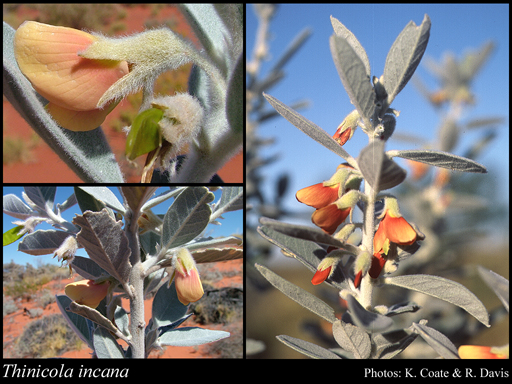- Reference
- Muelleria 15:12 (2001)
- Conservation Code
- Not threatened
- Naturalised Status
- Native to Western Australia
- Name Status
- Current
Slender shrub, 0.5-3 m high. Fl. red-pink, Jun to Sep. Red sand, sandstone. Sand dunes.







Scientific Description
Genus Thinicola. Form erect. Habit shrub, spindly shrub (broom-like). Stems Indumentum hairy, Pustules or glands absent, Striation (stems ribbed) not striate, Cross section terete, Spiny on any part of plant not spiny. Leaves or phylloclades Presence clearly present, Position alternate, Leaves simple, Leaves or phylloclade continuous with stem continuous with stem, Cross section of leaf or leaflet flat with flat margins, Margins of leaf or leaflet entire, Tuberculate tubercles absent, Pustules or glands absent. Length Leaf length 30-50. Width (entire leaves only) Leaf width 12-30. Scale leaves length mm long NaN (?). Indumentum Presence hairy, Type simple. Stipules Presence apparently absent even from the youngest leaves (?), present and persistent to older leaves (?) or present but early deciduous ( only visible on youngest leaves ) (?), Glands with glands (?) or without glands (?), Ribs ribbed (?) or ribless (?). Length Stipule length NaN (?). Bracteoles Presence present and persistent (?), absent (?) or present but early deciduous (?), Indumentum hairy (?) or glabrous (?), Striation striate (?) or not striate (?). Length Bracteole length NaN (?). Pedicel Indumentum hairy. Length Pedicel length 7-8. Calyx Pustules or glands absent, Ribs ribless, Enlarged in fruit not accrescent. Length Calyx length 8-13. Indumentum Presence hairy, Type with simple hairs. Corolla Colour patterning multicoloured, Colour (when multicoloured - choose one colour) pink or red, Colour (when multicoloured - choose a second colour) pink or red, Petal claws ( the narrow base of the petals present (?) or absent (?). Length Corolla length 20-24. Indumentum Presence absent. Standard Indumentum glabrous, Auricles not auriculate. Length Standard length 18-22. Wings Auricles not auriculate. Length Wing length 15-20. Keel Auricles not auriculate, Indumentum glabrous, Beak not beaked. Length Keel length 18-22. Stamens Number nine (?) or ten (?). Anthers anther length 1.3-1.6, Position at two different levels (filaments alternately long and short). Filaments Fusion free (or united at the very base) (?), united in an open sheath (?), united in a closed sheath (?) or united in an open sheath with one free stamen (?). Length Filament length 16-17. Ovary Placement stipitate. Indumentum Presence glabrous. Style Indumentum glabrous, Bearded ( with a tuft of hairs at apex ) not bearded, Apex terete. Length Style length 16-19. Fruit Type dehiscent (a pod or follicle) (?), indehiscent and not splitting into sections (?) or indehiscent and splitting into sections (schizocarps) (?), Constriction constricted between the seeds (?) or not constricted between the seeds (?), Compression flat or compressed (?) or round in cross-section (?), Placement stipitate (?) or sessile or subsessile (?), Beak beaked (?) or not beaked (?). Length Fruit length NaN (?). Width Fruit width NaN (?). Indumentum Presence hairy (?) or glabrous (?), Indumentum type with simple hairs (?) or with glandular hairs (?). Flowering time June, July, August or September. Distribution Botanical Province Eremaean, IBRA Bioregion Great Sandy Desert, Pilbara, Little Sandy Desert or Gibson Desert.
Distribution
- IBRA Regions
- Gibson Desert, Great Sandy Desert, Little Sandy Desert, Pilbara.
- IBRA Subregions
- Dune Field, Fortescue, Lateritic Plain, Mackay, McLarty, Rudall, Trainor.
- Local Government Areas (LGAs)
- Broome, East Pilbara, Wiluna.